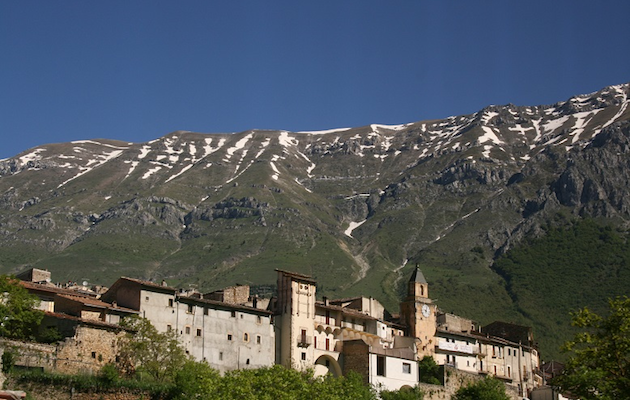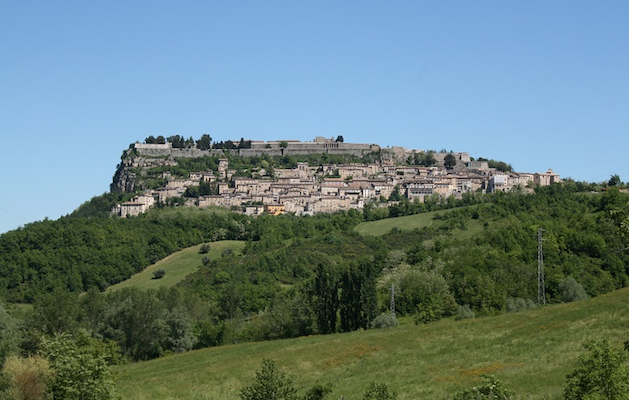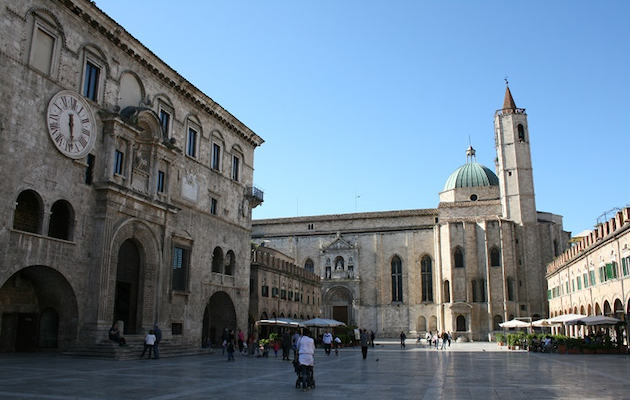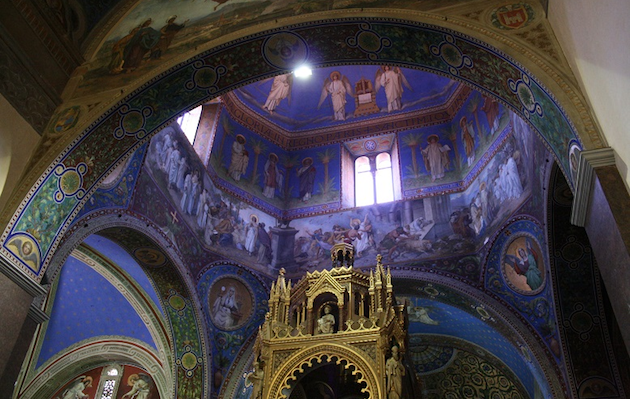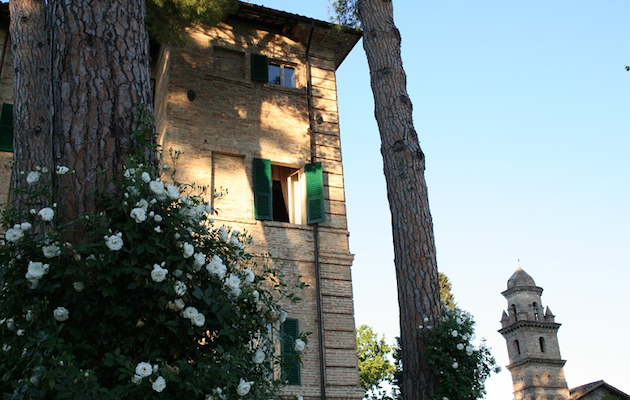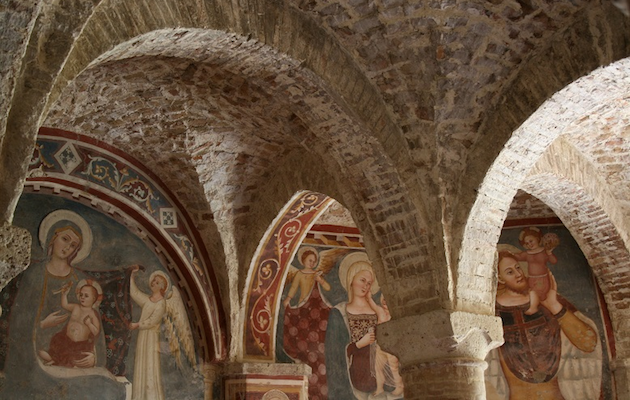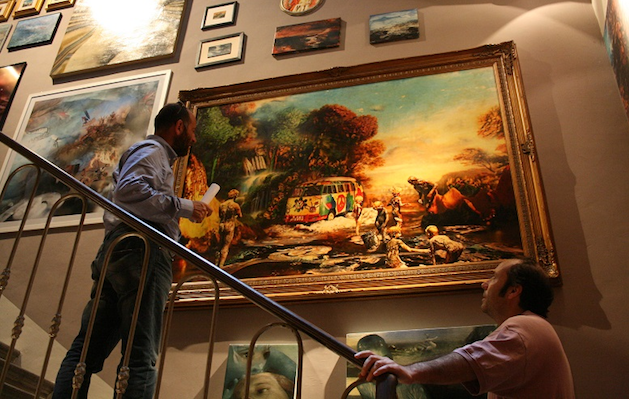Turning away from Abruzzo’s crude mountains, their edges began to soften as we meandered down delicate undulating hills to its neighbour, Le Marche. There are no sharp edges here, indeed the region has been described as ‘a patchwork quilt thrown over a lumpy mattress’ – a fitting description of the view from our coach window, certainly.
And here, from a man who couldn’t stop talking, we encountered the opposite. On the border of Le Marche province, another fortification; the massive Civitella del Tronto capping the walled town of Chieti. Majestic and imposing, and seemingly steeped in more history than its modest museum could accommodate we were, alas, spared of the fruits of its stories by Susanna. Susanna was beautiful. I would have followed her into battle. She was, however, about as bright as a brick. In a breathless mutter she guided us round the castle…and we guided her through history.
Fortunately, as introductions go, we were in for something a little more informed as we entered Ascoli Piceno, Le Marche’s regional capital. On the approach, through an abundance of trees, the views of rooftops and towers reminded me of Florence seen from the Piazzale Michelangelo but this was something to rival, if not better, that. To its credit over its more well-known sister, Ascoli is devoid of tourists, at least in the numbers Florence has to contend with. As we entered the city’s main square, Piazza del Popolo, I had the feeling we were in an Italy unchanged in centuries. Sharing the sun that beat down on us with its residents, we sauntered among the fruit market vendors by the church of San Francesco and dodged the muscle-flexing pretty boys peacocking themselves to the flirting girls as a line of elders looked on with a mixture of envy and disdain from the comfort of the cloisters’ shadows.
Arringo Square – the origin, incidentally, for the word ‘harangue’, after the political speeches held there in the Middle Ages – is flanked by the duomo and the town hall; home, too, to its art gallery and blessed with masters from the Renaissance, and here we were privileged to be given a tour by perhaps our most prestigious guide, Professore Stefano Papetti, the city’s Director of Museums. His knowledge notwithstanding, it was the anecdotal illustrations that added the texture to this particular dish. Ascoli Piceno was the birthplace of Michelangelo’s contemporary, Cola dell’Amatrice, who’s greatest legacy, bar these tucked-away masterpieces, was in lending his name to the dish Pasta alla Matriciana. It says something of the proliferation of Renaissance art that an artist is more known for pasta. But it was to our unending pleasure that we walked among these works; an extraordinary chasuble of gilded embroidery of Pope Nicholas IV from the 13th century, a stunning 15th century Crivelli altarpiece triptych and the Annunciazione by Pietro Alamanno complete with an image of the medieval town, an early reference point to the city’s history.
And here, too, we had an interesting insight on the city’s heritage. Older than Rome, the city was founded by its namesake, the Piceni tribe, but its history is shared not so much with Rome but leans closer to Croatia. For its medieval settlers the mountains were considered more treacherous than the Adriatic. No surprise, then, that Le Marche is at the forefront of the initiative to unite the two countries, sharing more than just a coastline, but history, culture and traditions.
It was over dinner at the Borgo Storico Seghetti Panichi – a house, that is, not a dish – in the company of the Principessa Giulia Pignatelli that we learned more about this initiative. Her daughter, Stefania, is championing the move to encourage tourism to the region through Le Marche Segrete, an alliance of ancestral landowning families devoted to preserving the history and artistic treasures of the region. We dined like lords at the Borgo as a company, in the manner guests would have – and still can – before the needs of privacy superseded decency, learning of its history; of Giulia’s mother’s experiences in the war when the house changed hands four times, of it being a favourite stopover for famed operatic tenor Beniamino Gigli and in whose room I was privileged to stay. Here was a guide of an altogether different nature, someone who had lived what they were relating, rather than reciting it.
Thus far I thought we’d run the gamut of tour guides; the scholar, the aristocrat, the politician, the bimbo. But, as our journey through Le Marche closed, as any maxim goes, we were saving the best to last.
In the village of Offida, its imposing 14th century church – so well kept it looks like a modern folly than something over 700 years old – is testament, really, to the Italians’ dedication to Catholicism that a town of a mere 5000 souls could create such a monument. But Offida boasts something more of the little-known history of Le Marche; its theatrical tradition. In the 18th and 19th centuries, so popular was this pastime that if your village didn’t have its own theatre, well, it simply didn’t bear thinking about. Offida was no exception and, short of space in which to construct one centrally, they did what any self-respecting creatives types do; convert the town hall. Who needs a political stage when you can have an entertaining one?
Offida’s is a rich history, but I doubt I’ll remember it for that. For it was here that we were handed over to Leonardo, the last and most memorable of our tour guides. Our itinerary was tight; we had another town, Moresco, on the agenda, not to mention calling in on a contemporary artist before making for the port and our crossing across the Adriatic. Leonardo was a flamboyant lothario, warm, entertaining and more interested in relating tales of his love life than he was about the history passing us by.
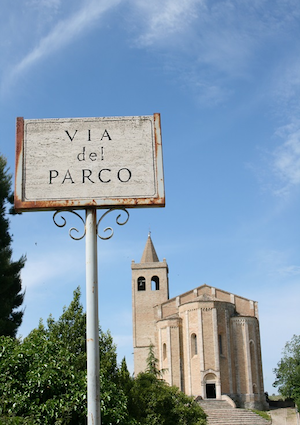 Clearly instructed to maintain our tight schedule, he was also a man punctilious in his time-keeping – when it suited him. We were hurried through the lace museum in Offida, shot through the winery the town was also known for and then gave Moresco all of ten minutes. “There is a famous tower,” he pointed out, gesturing to an 800 year old fortification, the symbol of the town. And that was it. Between stops we passed a magnificent dome-capped cathedral on the horizon. An inquisitive member of our number asked after it. “Oh, that is a beautiful church,” Franco replied, and resumed his anecdote of an amorous conquest.
Clearly instructed to maintain our tight schedule, he was also a man punctilious in his time-keeping – when it suited him. We were hurried through the lace museum in Offida, shot through the winery the town was also known for and then gave Moresco all of ten minutes. “There is a famous tower,” he pointed out, gesturing to an 800 year old fortification, the symbol of the town. And that was it. Between stops we passed a magnificent dome-capped cathedral on the horizon. An inquisitive member of our number asked after it. “Oh, that is a beautiful church,” Franco replied, and resumed his anecdote of an amorous conquest.
But this risible clown cemented his infamy as we arrived at the house of Paolo Consorti, a contemporary artist and important keystone of the ‘Adristorical’ principle of seeing the region through artists’ eyes. As Paolo gave us his tour, his chihuahua Goliath nipping at his heels, Leonardo looked visibly unmoved, and kept reminding us of our time-keeping. Until, that is, he spotted a piano in Paolo’s dining room. “Do you play?” he asked. Paolo nodded and offered us a sombre tune. Not to be outdone, Leonardo slid his host out of the way and banged out a riotous saloon bar barnstormer. “Now we can go,” he declared, finishing with a flourish, and we marched on to Ancona and our waiting ferry for the sail across the Adriatic.
Leonardo’s egotism, however, was countered by his convivial spirit. Ever smiling and raising a laugh as he did, it was a delightful antidote to the academia that had preceded it, adding colour and texture to the tour of these tucked away corners of Italy. To the list of scholar, visionary, princess and politician that can bring a visit to these lesser-known lands to life, one might consider including a clown.

